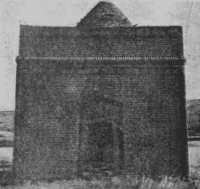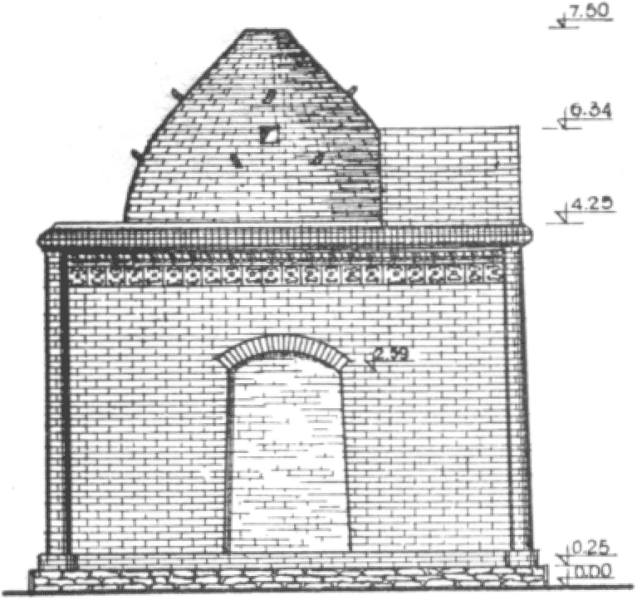Вы здесь
Mausoleum Zherapay-Maikin.

Tours to ancient monuments of Ulytau.
"Architecture was the main chronicle of mankind"
Victor Hugo.
Ancient monuments of Ulytau.
Zherapai-Maikin mausoleum is located at an altitude of 345 meters above sea level, located on outskirts, in northern part of village of Korgasyn, 156 meters from left bank of Kara-Turgai river, 69 kilometers northwest of village of Ulytau in Ulytau district of region of same name.
“80 - 90 kilometers from the village of Ulu-Tau, towards Atbasar, near the Devi (Kurgasyn) tract, the former British concessional lead mining, is the Zherapai-Maikin mausoleum. It is located in the upper reaches of the Kara-Turgai River, close to the upper reaches of the Kara-Kengir River.
It is a small building in size, made of dark red baked bricks on clay mortar. In terms of composition, it belongs to the central domed buildings with a single chamber. The mausoleum was erected on a shallow foundation made of limestone stone on clay mortar.
Its base is a cube, on which a cone-shaped dome rises. A small parapet (imitation of a peshtak) with a height of 1.09 meters was erected on the front facade, oriented to the southwest side. The height of the cube from the ground to the edge of the cornice is 4.20 meters, the height of the conical dome is 2.90, and the total height of the mausoleum is 7.10 meters.
For the decorative and architectural design of the facade, shallow niches were used on the side and rear walls, half-columns made of curved bricks at four corners, a frieze made of various ornamented terracotta tiles (without glazing) and an oval cornice.
Wall niches, slightly tapering upward, are covered with sluggish bow-shaped arches. The ornament of the frieze tiles is very simple - in the form of curls set in pairs against each other, like "koshkar-muyiz", drawn in relief.
Initially, before firing, their background, apparently, was painted in a greenish-red color, which later faded, as can be judged by the remaining traces. The design of the cornice is completely original, not found anywhere.
Above the frieze, one row of bricks was laid “on the edge”, a shallow profile in the form of a comb (zigzag) was applied to it, then there was one row of bricks in “spoons”, and, finally, on top of the cornice, the cornice was completed with two halves of curved bricks, forming a half-shaft along the section.
In the ordinary masonry of the parapet on the front facade, there is a small belt, designed as a frieze, which slightly revives its plane. In terms of the mausoleum, both in the outer outline and in the inner one, it is a square with sides equal to 5.68 x 5.60 and, respectively, 3.46 x 3.52 meters.
Minor deviations in the dimensions of identical sides were due to the fault of the builders, who did not accurately perform the work. Along the main axis of the building, on the front facade in a shallow niche, there is a doorway measuring 1.36 x 0.79 meters.
It is covered with an arch-shaped brick lintel. In contrast to the rectangular doorways used in ancient mausoleums, which are laid directly from the ground and are convenient for entering the mausoleum, the opening is made here over a high threshold with a door that closes with a hook and lock.
This speaks of the utilitarian use of the structure. Inside the mausoleum, on the side walls and in sails, traditional shallow niches are arranged, covered with gentle, bow-shaped arches, facilitating the transition from a square plan to an octagonal one.
The arches are drawn weak, their proportions are poor. Behind the arches there are sails, decorated with brickwork in the form of overhanging rows, which end on the 9th row with a silk arch. Zigzag brickwork is made along the upper belt of the walls, and a cone-shaped dome rests on it.
It is folded simply, with horizontal inlaid rows using the "false vault" laying method, which explains its elongated shape. There are small windows in the form of light openings in the direction of the main axes of the building.
Light penetrating through them weakly illuminates the inside of the camera. Outside, the dome has no drum. It is placed directly on the floor. Traditionally, two rows of small perches are staggered in its shell. To climb the domed platform, in the right corner of the entrance, there is a small manhole staircase about 38 cm wide, leading up.
Passage through it is extremely difficult. The brick floor in the mausoleum, laid in one row "flat", does not have structures in the form of a sagana, indicating to the burial place of the deceased. Now this monument is in satisfactory condition due to the foundation under the building and the good quality of construction work.
According to residents of the Ulu-Tau village, it was built in the nineties of the 19th century by Bay Zherapay-Maikin. In terms of style and quality of construction work, it, like the mausoleum of Kosubai-Kara and Kara-Kul, refers to the period of the rise of construction activity in Kazakhstan.
The analysis of these monuments speaks of the searches of the architects of that time for new forms in architecture, based on the achievements of both Kazakh and Russian building art.
Geographic coordinates of Zherapay-Maikin mausoleum: N49°13'03 E66°39'26


Authority and photos:
G.G. Gerasimov. "Architectural monuments of the valley of the Kara-Kengir river in Central Kazakhstan". Publishing house of the Academy of Sciences of the Kazakh SSR. Alma-Ata. 1957.







